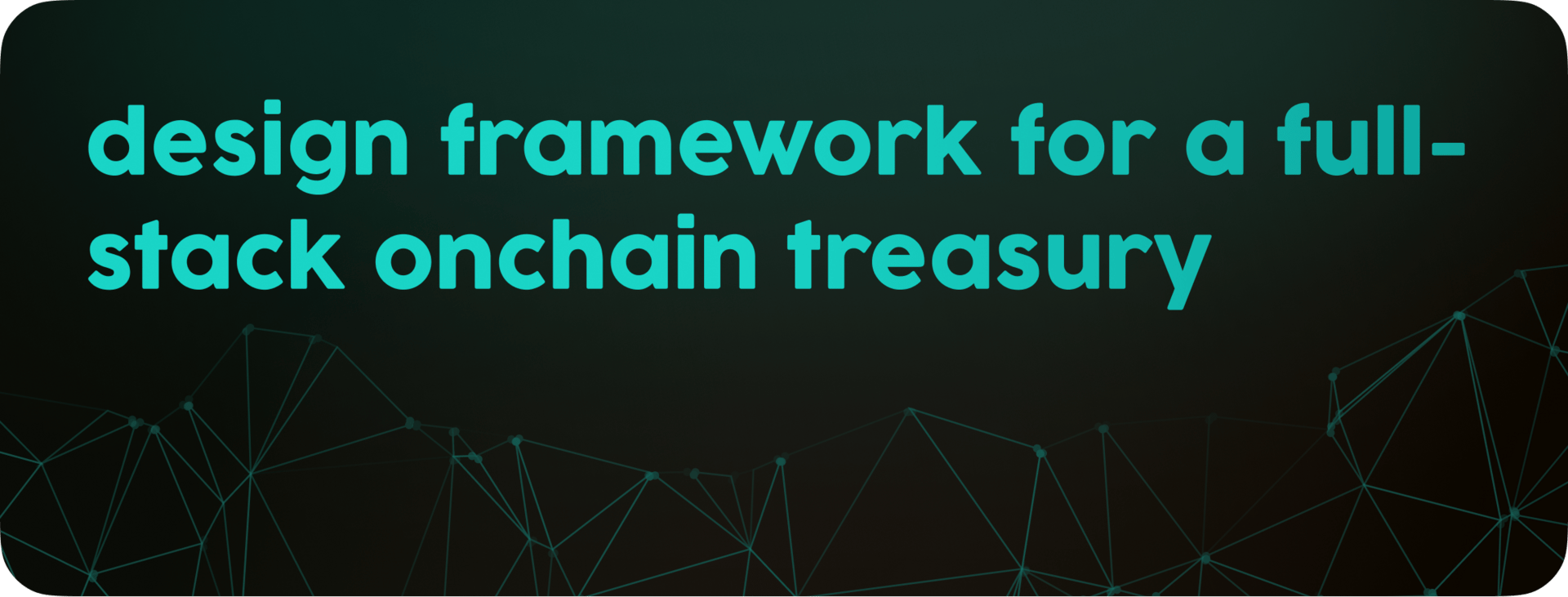- alpha unhashed
- Posts
- beyond risk curators in Defi
beyond risk curators in Defi
welcome to alpha un#, aarnâ's fortnightly newsletter

This edition is adapted from a recent deep-dive by Sri Misra, founder of aarnâ, who unpacks the real architecture behind DeFi asset management — and what needs to evolve before treasuries, funds, and serious allocators can treat it as infrastructure.
TL;DR: The last cycle gave us curated vaults and dashboard-led “risk overlays” that broke under stress. What DeFi needs next is not better curators, but full-stack, agentic asset management rails — built on contracts that own execution, enforce risk in code, and can act at the speed of loss. Anything else is still an overlay.

The pattern over 2021–2025 was fairly consistent.
A protocol or chain wants safer growth and better optics. A curator comes in with models, backtests, and risk reports. Together they design vaults, set parameters, pick venues, and sometimes launch “curated” strategies on top of existing protocols. Treasuries, funds, and larger users then allocate into those products as a seemingly safer route into DeFi yield.
On paper, this splits roles neatly. In practice, a few structural facts remain true:
> The vault contracts and redemption logic sit with the underlying protocol or venue.
> The governance rights and keys sit with DAOs, councils, and multisigs.
> The curator operates as a service layer on top, not as the rail itself.
That has predictable consequences.
Curators can recommend, but often cannot execute without a social and governance process. They depend on other protocols’ upgrade paths, collateral listings, and failure modes. Their economics are driven by mandates and AUM, not by the long term health of a shared infra layer.
When markets are quiet, this is tolerable. Under stress, the same weaknesses show up again and again.
Yield-bearing “stable” structures, with offchain managers and opaque reserves, slip into portfolios as near-core collateral. Those assets get looped across venues and vaults, so the same underlying risk is counted multiple times. Utilisation and rates spike in lending markets while everyone waits for proposals, forum debates, and signatures. Vault token holders and end users end up taking the first loss, long after fees and incentives have been collected upstream.
The point is not to single out one curator or one vault design. It is to notice that the architecture puts the main risk engine outside the rail that actually holds user assets.

Curator overlay model | Full-stack onchain treasury/asset management | |
Role in Stack | Sits on top of existing protocols and vaults as an advisor or external manager | Is the treasury and vault infra itself, using other protocols and venues as components |
What you actually hold | LP/ vault tokens from someone else’s protocol,”curated” by a third party. | Native vault tokens from a single stack that controls venues,limits, and rules |
Risk & Execution | Risk lives in reports and forums;execution depends on DAO votes and multisigs | Risk policy is encoded in config and contracts;execution runs automatically within those limits |
Composability | Products are usually sioled per venue or client,with bespoke integrations each time | Vault tokens are neutral building blocks that wallets,treasuires, and protocols can plug into as base rails or collaterals. |
This is not a claim that the curator model has no place. It is a description of what it is: an overlay.
What is missing in DeFi today is a native asset-management rail - a vault and treasury layer that both project treasuries and serious allocators can plug into directly, with curator insight feeding in as a signal, not as the only line of defence.

Once you look at the past weeks through that lens, the main incidents start to rhyme.
In early November, Stream Finance disclosed a roughly $93m loss at an external fund manager, paused deposits and withdrawals, and saw its yield-bearing stablecoin xUSD drop more than 70% from its peg. That single failure cascaded quickly. Elixir’s deUSD had lent about $68m USDC to Stream – roughly 65% of its backing – and deUSD subsequently collapsed over 95% from $1 as confidence evaporated.
Independent DeFi analysts then mapped around $285m of cross-protocol exposure tied to Stream’s xUSD, xBTC, and xETH across lending markets like Euler, Morpho, and Silo. A significant share of that exposure did not come from “retail degen” deposits straight into Stream, but from managed vaults and structured strategies that had integrated Stream’s assets as collateral or backing. End users thought they were in curated, risk-managed yield products; under the hood, those products had effectively white-labeled Stream’s hybrid CeDeFi risk.
When risk policy lives in forum posts and Google Docs, it becomes optional in practice. The moment a “stable” structure picks up yield and a few positive anecdotes, it makes its way into portfolios as if it were core collateral. There is rarely a single canonical source of truth that says: this is the maximum exposure we are willing to take to this issuer, this venue, this strategy.
When vault infra is treated as an implementation detail, composability becomes fragile. Users end up holding a long chain of wrappers and LP tokens, many of which are not designed as neutral, reusable building blocks. Some of the worst recursive loops were not the result of any one team being reckless; they were the result of everyone assuming “this token is already whitelisted somewhere else, so it must be fine to build on”.
Seen this way, the blow-ups are less about individual mistakes and more about three structural gaps:
> risk rules are not consistently machine-enforced,
> execution authority is not aligned with the speed of risk,
> vault contracts are not treated as primary, composable objects.
In practice, that points toward agentic onchain treasury structures: systems where an agent layer has standing but bounded authority to manage positions across venues on behalf of a vault network, while humans stay in the loop for major changes and oversight rather than as ad hoc fire fighters.

Whether you manage a DAO treasury, a fund, a family office book, or a large personal DeFi stack, the recent pattern of failures points to what a solution has to look like. Not a specific product, but the minimum design for a full-stack onchain asset management layer.
First, risk policy has to be explicit and enforced by code, not just by documents.
A real fix starts with one canonical source of truth: which assets count as core collateral and why, how much exposure you will take to any one asset, issuer, or venue, and what happens if a whitelisted asset pauses redemptions, depegs, or loses a key market. In a full-stack onchain treasury, those rules live in configuration and contracts the vault logic actually reads, not only in PDFs and forum posts.
Second, execution rights need to match the speed of risk.
The system that holds positions needs authority to act at the timescale at which those positions can go wrong. That means a defined execution engine – often an agent layer – with a clear mandate: operate inside pre-set policy bands, enforce caps, halt inflows, step down exposure when thresholds are breached, and leave a transparent audit trail. Governance still sets the rules and oversees changes, but day-to-day risk actions move from ad hoc human reactions to structured, onchain behaviour.
Third, treat vault infra as the product, not an implementation detail.
In a full-stack design, the primary object users and treasuries interact with is the vault or wrapper contract itself. Everything else is UI. Those contracts should be standardised (ERC-4626 or similar), simple to integrate, and structurally conservative: no opaque wrappers, no unnecessary recursion, no self-referential collateral loops as the default pattern. Designed this way, vault tokens become neutral building blocks that wallets, custodians, DAOs, and funds can all safely plug into.
Fourth, curators become upstream signal providers, not operational choke points.
Specialist firms still matter – to stress-test parameters, model shocks, and build monitoring. In a full-stack, agentic treasury, their output flows in as inputs to the policy and execution layer, not as the sole operator of the book. The rail ingests those signals, updates configuration, and executes through its own infra, instead of depending on one external curator to manually steer positions across multiple venues.
Put together, this is less a list of “nice to haves” and more a checklist for what a full-stack, Agentic Onchain Treasury(AOT) actually is. If your asset-management layer cannot satisfy these conditions in practice, you are still running a curator overlay – and the same failure modes will keep showing up.

We are early in a new phase of capital rotation. There is a real risk that DeFi simply repeats its habits: rebrand complex stable structures, wrap them in new “managed” products, add a better dashboard, and run the same play until something snaps again.
If DeFi is going to mature into real market infrastructure for treasuries, funds, family offices, and high value users, the stack has to change where risk rules live, who can act on them, and what users actually hold. Risk policy has to move into code – onchain wherever feasible, and into an agentic control layer for what cannot be fully onchain. Execution has to move from fragmented human intervention to coherent, rule-bound control. And the primary object people hold has to be neutral vault tokens that function as rails, not one-off products.
Whether you run a project treasury, manage a fund, allocate for a family office, or are a high conviction user looking to deploy 10k or more into DeFi, the question cannot stop at “which curator do we hire” or “who is endorsing this vault”.
A better starting point is:
> What is our full-stack onchain asset management layer,
> and does it actually deserve the risk and capital we are placing on it?

On Nov. 3, 2025, DeFi protocol Stream Finance lost $93m after Balancer-related mismanagement, causing its xUSD stablecoin to crash and triggering a broader crisis of confidence in DeFi “curators.” Contagion hit Morpho and others, exposing leverage, opacity and concentration risks, and driving calls for more transparent, lower-risk curator models.
In late 2025, DeFi “risk curators” faced a major stress test as vaults using risky or algorithmic stablecoins as collateral hit 100% utilization, trapping lenders. Gauntlet paused a Compound vault after deUSD’s depeg, contagion spread via Morpho, and TVL in curated vaults plunged from about $10B to $7.5B.
Circle, issuer of USDC, has launched StableFX, a stablecoin-based FX engine on its new Arc blockchain, now in testnet. The service lets verified institutions trade stablecoin currency pairs 24/7 with onchain, real-time settlement and RFQ pricing, aiming to cut cross-border payment friction and settlement risk.
top DeFi tweets
@robdogeth warns DeFi stablecoin xUSD is undergoing a major depeg after a $93m loss at Stream Finance exposed heavily leveraged looping strategies, leaving about $285m across lending markets at risk and highlighting hardcoded oracle and transparency failures.
According to @matthew_sigel, JPMorgan warns MicroStrategy ($MSTR) may be removed from major equity indices as MSCI reviews digital-asset treasury firms, potentially triggering $2.8B in outflows from MSCI indexes and up to $8.8B if others follow.
At @Vault__Summit, @A_Leutenegger of @AragonProject summed it up: DeFi vaults have evolved from “simple, predictable contracts” into complex, intermediary-filled strategies—more sophisticated, but riskier. As @Raph_Bloch asks how vaults work today, the real drama centers on one word: curators.
reflections-

aarnâ is now on iOS & Android! Download now and experience the future of finance on your phone!
disclaimer:
this newsletter is for informational purposes only and should not be considered financial or investment advice. The information provided does not constitute a recommendation to buy, sell, or hold any digital asset or engage in any specific DeFi strategy. always conduct your own research and consult with a qualified financial advisor before making any investment decisions. know more
Gain an edge in DeFi alpha with aarnâ’s AI-driven insights and DeFi vaults. Try the dApp now.

